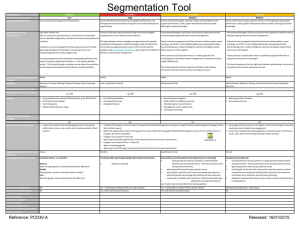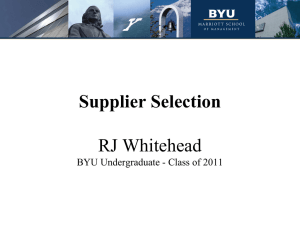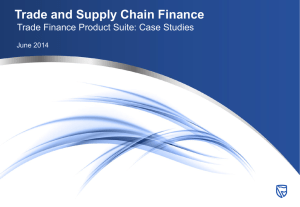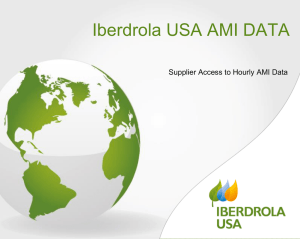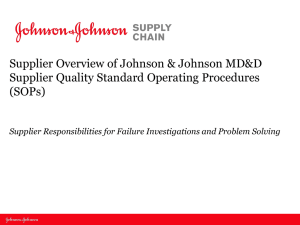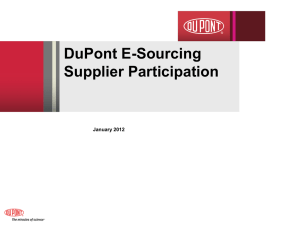Supplier Selection
advertisement
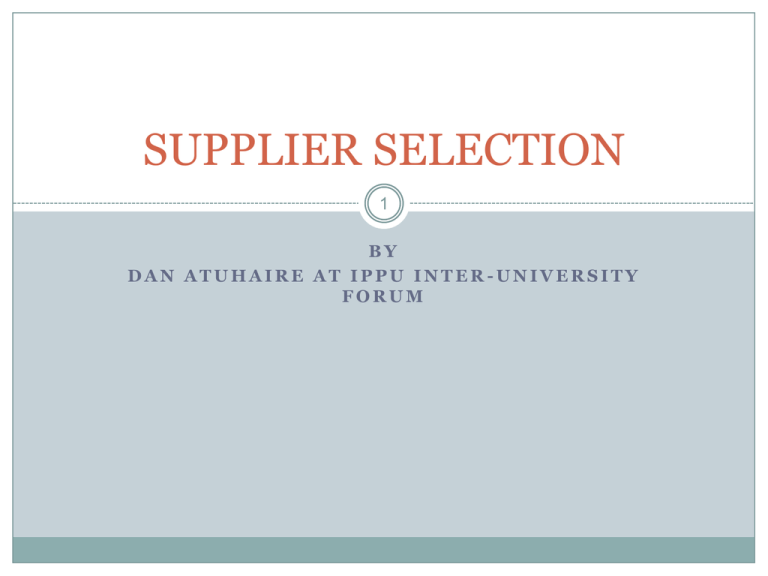
SUPPLIER SELECTION 1 BY DAN ATUHAIRE AT IPPU INTER-UNIVERSITY FORUM Presentation guideline 2 Definition of Supplier selection Typical steps in Supplier Selection Highlights why each step is important and how the steps are interrelated. Definition of Supplier selection 3 Supplier selection is the process by which firms identify, evaluate, and contract with suppliers The supplier selection process deploys a tremendous amount of a firm’s financial resources. In return, firms expect significant benefits from contracting with suppliers offering high value. Steps Involved in supplier selection 4 The typical steps of supplier selection processes: identifying suppliers, soliciting information from suppliers, setting contract terms, Negotiating with suppliers, and evaluating suppliers Eight common supplier selection criteria 5 Cost Quality & Safety Delivery Service Social Responsibility Convenience/Simplicity Risk Agility is defined as "the ability of a [system] to rapidly respond to change by adapting its initial stable configuration". Supplier Selection for Supplier MGT Process 6 Supplier Development,Classification & evaluation 7 Supplier development can be loosely defined as the process of working collaboratively with suppliers to improve or expand their capabilities. . An example may be teaching a supplier how to manufacture a type of item that they never be manufactured before for the purposes of giving you the option to buy, rather than make, that item You can categorize the suppliers that are strategically important and critical to your business. Supplier evaluation Supplier evaluation is a process applied to current suppliers in order to measure and monitor their performance for the Identifying potential suppliers 8 To survive in the intensely competitive global economy, it is often critically important to not only develop existing suppliers but also to discover new suppliers Importance of new suppliers First, there may exist new suppliers that are superior in some way to a firm’s existing suppliers eg a new supplier may have a structural cost advantage over existing suppliers. existing suppliers may go out of business, or their costs may be increasing Identifying potential suppliers 9 The buyer may need additional suppliers simply to drive competition, reduce supply disruption risks, or meet other business objectives such as supplier diversity . supplier qualification screening 10 • Reasons for supplier qualification screening among other include the following; The need to verify the supplier’s ability to meet the buyer’s myriad requirements. Supplier non-performance on even the most basic level, and for the most simple commodity, can have dire consequences for the buyer. safety issues have been traced back to suppliers failing to meet a buyer’s requirements, resulting in dangerous lead paint in toys, unsafe car tires, and pet food containing poisonous chemicals Supplier qualification screening process 11 To avoid dire supplier non-performance, buyers take proactive steps to verify a supplier’s qualifications prior to award a contract. The primary goal of “supplier qualification screening” is To reduce the likelihood of supplier non performance, e.g. late delivery, non-delivery, or nonconforming (faulty) goods. the supplier will be a responsible and responsive partner in the day-to-day business relationship with the buyer Supplier qualification screening steps 12 Reference checks. The buyer may contact previous customers and ask about the supplier’s delivery performance, adherence to contract terms, what (if any) problems arose and how they were resolved, etc Financial status checks. For example, if the supplier has recently assumed significant debt, Surge capacity availability. The supplier’s capacity to increase delivery quantities within short lead times is important as the buyer may be uncertain about their exact quantity needs over the life of the contract Supplier qualification screening steps 13 Indications of supplier quality. The buyer might require that suppliers have ISO 9000 certification to actually see if an adequate level of quality is achievable Ability to meet specifications. To check the supplier’s capabilities the buyer might ; Request samples of supplier products Visit the supplier’s production facility and interview line workers Audit the production facilities to ensure that production can and will only proceed in a manner approved by the buyer. Creating a supply base 14 Suppliers who have passed the qualification requirements and are eligible for contract award are commonly referred to as “pre-qualified” suppliers If the buyer utilizes short-term contracts and reprocures the same item, it typically makes sense to have pre-qualified suppliers who will compete for these contracts it might still make sense to use a pre-qualified supply base: If the supply base members can compete to produce item’s for long-term contract Creating a supply base 15 Finally, using a supply base not only reduces qualification screening costs but Also allows for the development of standardized contracts, terms and conditions for pre-qualified suppliers, thereby streamlining administrative processes involved in contracting. Information requests to suppliers 16 Once the buyer has identified potential suppliers, the next step in supplier selection is to formally request suppliers provide information about their goods or services The buyer makes one of three types of information requests to suppliers. Request For Information (RFI) when the buyer seeks to gain market intelligence. Request For Quote (RFQ) issued when the buyer can develop a statement of work that states the exact specifications of the good or service needed Information requests to suppliers 17 Request For Proposal (RFP) is issued when the buyer has a sense of the marketplace and has a statement of work which contains a set of “performance” Contract terms 18 The supplier selection process culminates in a contract between the buyer and one or more suppliers. contract with a supplier specifies what the supplier should do and how they will be paid by the buyer Contracts can specify any number of payment and nonpayment arrangements. Payment terms. In a fixed-price contract, the price term specifies what the supplier will be paid regardless of the actual cost to execute its contractual obligations Section 7-general conditions of contract 19 • The General Conditions of Contract (GCC) contain standard provisions that have been designed to remain unchanged and to be used without modifying their text. The GCC clearly identify the provisions that may normally need to be specified for a particular bidding process and require that such provisions be introduced through the SCC. • The GCC are Contract documents and, therefore, are a part of the Contract Role of the CC • To ensure that the provisions of GCC are not changed Section 8-Special conditions of contract 20 The Special Conditions of Contract (SCC) supplement the GCC by modifying conditions applicable to an individual contract, such as payment terms or the period of warranty The SCC prevail over the GCC. Role of the CC The role of the CC is to ensure the SCC apply to the specific procurement. Section 9-Contract forms 21 • These include the agreement form, performance security and advance payment security • The purpose of including these forms in the Bidding Document is to notify the Bidders of the type and detail of the Contract they would receive in the event of an award. No input is required by the PDE when drafting the Bidding Document and there is no requirement for Bidders to submit these forms with their bids. Contract form Cont… 22 • Agreement- The completed Agreement will form part of any resulting Contract. However, the details to be completed on the Agreement are specific to the successful Bidder and therefore should be left blank for inclusion in the Bidding Document. • After notification of award, the Procuring and Disposing Entity should prepare the Agreement using the Agreement Form and send it to the successful Bidder Contract forms Cont…. 23 • Performance security and advance payment security- If a Performance Security is required, the form should be completed by the financial institution and returned to the Procuring and Disposing Entity, by the Provider with the signed Agreement • If any advance payment is specified in the contract, the Advance Payment Security should be completed by the financial institution and submitted by the Provider to the Procuring and Disposing Entity with an invoice. • The PDE is not required to input any information to the security forms. Contract forms cont:…………….. 24 Role of the CC The role of the CC is to ensure the contract forms contain provisions that result into a binding contract. That the provisions in the contract forms has relevant signatories and financial institutions incase of performance security and advance payment security. 25 End of the presentation

